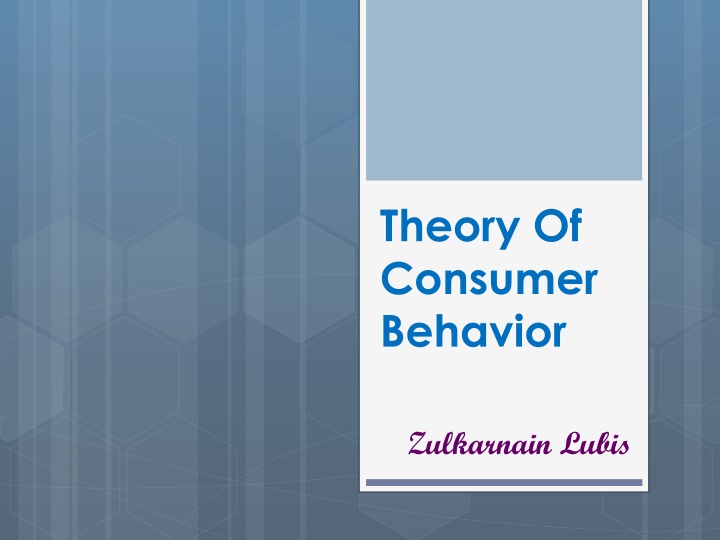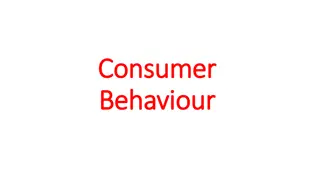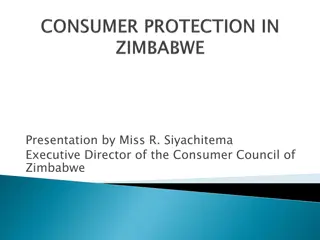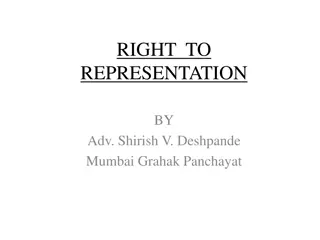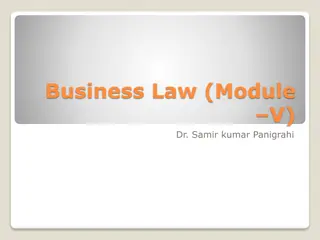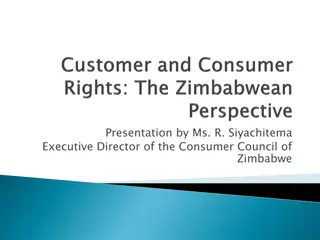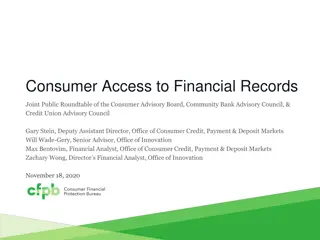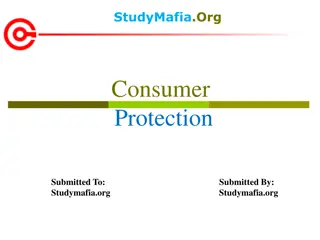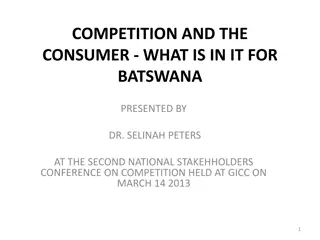Theory of Consumer Behavior by Zulkarnain Lubis
In "Theory of Consumer Behavior" by Zulkarnain Lubis, the intricate dynamics of consumer decision-making are explored. This insightful text delves into the theoretical foundations and practical applications that shape consumer behavior in today's market. From preferences and choices to purchasing patterns and economic influences, this book offers a comprehensive analysis that is essential for understanding the complexities of consumer behavior.
Download Presentation

Please find below an Image/Link to download the presentation.
The content on the website is provided AS IS for your information and personal use only. It may not be sold, licensed, or shared on other websites without obtaining consent from the author.If you encounter any issues during the download, it is possible that the publisher has removed the file from their server.
You are allowed to download the files provided on this website for personal or commercial use, subject to the condition that they are used lawfully. All files are the property of their respective owners.
The content on the website is provided AS IS for your information and personal use only. It may not be sold, licensed, or shared on other websites without obtaining consent from the author.
E N D
Presentation Transcript
Theory Of Consumer Behavior Zulkarnain Lubis
Consumer preferences and utility. Indifference curves, Marginal rate of substitution, Indifference map, The consumer s budget constraint. Utility maximization Individual consumer and market demand Substitution and income effects: why demand slopes downward.
Consumer Behavior Concept Consumer behavior concept is abstract or simplicity of the process and the way of a consumer as an individual in making decision The main goal of consumers to consume a product is maximizing satisfaction Because the income is limited, choices must be made about how to spend their limited income in order to get the maximum satisfaction
Principally, the level of consumer satisfaction can be mentioned as complying the need, the want, and the desire of consumers related to consuming a certain good or service Consumer satisfaction, actually, related to the quality of the product which can be identified by 8 indicators: performance, feature, reliability, conformance, durability, serviceability, aesthetic, and perceived quality Usually, the characteristics of the product that the consumers want in order to meet their satisfaction are faster, cheaper, and better which are related to the time dimension, price dimension, and quality dimension
The relation between the want of consumers and the availability of the product and or consumer satisfaction Consumers Want A B Attention Bravo Consu mers Do not Find Consu mers Find D C Don t worry Be happy Consumers Do not Want Cut or communi cate
Utility and Utility Function o In terms of consumer behavior, satisfaction is called as utility. o Utility can also be defined as the benefits consumers obtain from the goods and services they consume o The level of utility can t be counted or measured and there is not found a utility meter either. o The level of utility is arbitrary and determined as an ordinary scale based on the combination of goods and services consumed Utility function
The utility function: an equation that shows an individual s perception of the level utility that would be obtained from consuming each conceivable bundles of goods and services Suppose there are only two goods consumed, X and Y, the utility function of a person who consume these two goods can be written as U = f(X, Y) where X and Y are, respectively , the amount of goods X and Y consumed, U is the level of utility the person receives from each combination of X and Y, while f means a function of or depend on
Indifference Curve Related to the utility function, there is a fundamental tool for analyzing consumer behavior, an indifference curve An indifference curve: a set of points representing different bundles of goods and services , each of which yields the same level of total utility The main assumption in analyzing consumer behavior based on indifference curve is that consumers will do the rational choice
The consumers optimization problems All individuals make consumption decisions with the goal of maximizing their total satisfaction from consuming various goods and services, subject to the constraint that their spending on goods and services exactly equals to their incomes Consumers do not spend either less or more than their incomes (no borrowing, no saving) Consumers make their purchasing decisions when they are completely informed about all things that matter, they know the full range of products and services available, as well as the capacity of each product to provide utility Consumers know the price of each good and their incomes during the time period in a question
Properties of consumer preferences Customers could be able to rank (or to order) various combinations of goods and services according to the level of satisfactions associated with each combination The combinations of specific quantities of goods or services are called consumption bundle There are several Important assumptions must be made about how people rank bundles of goods (consumer preferences): Complete preference ordering (completeness) Transitive preference ordering (transitivity) More is preferred to less (non satiation) Convexity
Completeness If there were only two goods consumed, e.g. Rice (B) and Textiles (T) A consumer can decide whether B is preferably of T, T is preferred than B, or he or she is indifferent between B and T The consumer s preferences are complete if the consumer can do this for every possible pair of consumption bundles Transitivity If the product X> Y, Y> Z, then X> Z. If X = Y, Y = Z, X = Z The fact is not necessarily so
Non Satiation Consumers always prefer to have more of a good rather than less of the good The fact is also not necessarily so Convexity Consuming a combination of two products is better than 1 product X and Y are two products consumed, it is better to choose a part of the X and a part of Y rather than all X or all Y.
Indifference curve as a curve of the utility function: representative with the typical assumed shape Product 2 D Y3 Y30 A C Y1 Y10 B U3 Y2 U2 Y4 Y40 U1 X3 X30 X4 X40 X10 Product 1 X2 X1
All combinations of product 1 and 2 along indifference curve U1 yield the consumer the same level of utility i.e. A (X1, Y1) and B(X2, Y2) Point C(X2, Y1) represent a higher level of utility than A or B, because X2 > X1 (for A) and Y1 > Y2 (for B) Downward sloping: since the consumer obtains utility from both goods, when X more added, Y must be taken away in order to maintain the same level of utility (from A to B) Convex: a diminishing marginal rate of substitution, to which we now turn For the same change in X (X3 to X30, X1to X10, and X4 to X40), Y3 > Y1 > Y4
The combinations of consuming X and Y yield the level of utility, U = 100 Combi nation X Y Utility level Combi nation X Y Utility level A 1 100 100 D 50 4 100 B 10 20 100 E 80 2.5 100 C 25 8 100 F 100 1 100
Indifference Curve representing the relation between the consumption of X and Y and the level of utility 100 U = 100 50 Y 0 0 50 X 100
Marginal Utility Function (MU) The marginal utility function: the addition to total utility that is attributable to the addition of one unit of a good to the current rate of consumption, holding constant the amounts of all other goods consumed If UX : utility function, the marginal utility function (MUX) would be : MUX = UX/ X In the concept of managerial economics, in the short run , as the consumption of a good increases, the marginal utility from additional unit of the good diminished (it is said as the principle of diminishing marginal utility)
No Good X Utility (U) X U MU = U/ X 1 2 3 4 5 6 7 8 9 10 11 12 13 0 1 3 4 7 10 12 13 14 16 19 20 21 0 26 66 74 98 113 119 120 120 118 110 106 100 - 1 2 1 3 3 2 1 1 2 3 1 1 - - 26 40 14 24 15 6 1 0 -2 -8 -4 -6 26 20 14 8 5 3 1 0 -1 -2.67 -4 -6
30 120 110 100 U 20 90 80 MU TU 70 10 60 MU 50 40 0 30 20 0 10 20 0 10 20 X X Utility Function (U) and Marginal Utility (MU) at various consumtions of X
Marginal Rate of Substitution (MRS) Marginal rate of substitution (MRS) : A measure of the number of given up per unit X added so as to maintain a constant level of utility X increase 1 unit from X1 to X10, in order to hold the same utility, Y should decrease from Y1 to Y10, the combinations change from A to B MRSXY = - Y/ X The slope at A is bigger than that in C, indicating the MRS decreases as the consumer moves down an indifference curve A Y1 Y10 B C X20 X10 X2 X1
Indifference curves are negatively sloped and convex Moving along an indifference curve, when the consumption of one good is increased, consumption of the other good is necessarily reduced by the amount required to maintain a constant level of utility For a unit increase (decrease) in X, the MRS measures the decrease (increase) in Y needed to keep utility constant For very small changes in X, the MRS is the negative of the slope of the indifference curve at a point The MRS decreases as the consumer moves down an indifference curve
The change in total utility (U) = the results when both X and Y change by small amounts is related to the marginal utilities of X and Y; U = X MUX + Y MUY Since the level of utility is held constant, U = 0 and X MUX + Y MUY = 0 or - Y/ X = MUX /MUY X MUX = - Y MUY MRSXY = - Y/ X MRSXY = MUX /MUY
The Consumers Budget Constrain Consumes normally have limited income and goods are not limited, remember that the main goal of consumers to consume goods are maximizing satisfaction, but because the income is limited and goods are not limited, choices must be made about how to spend their limited income in order to get the maximum satisfaction To understand how the limited income in a way that gives the maximum possible utility, let s say a consumer s income (disposable income) is equal to I which is used to spend on goods X1, X2, X3, ., Xn, with respective price p1, p2, p3, ., pn, then the consumer s budget line is written as: I = p1 X1 + p2 X2 + p3 X3 + + pn Xn
The budget constrain can also be written : X1 = I/p1 - p2/p1 X2 + p3/p1 X3 + + pn/p1Xn The budget line which is the curve of consumer s budget constrain for two goods consumed (X and Y) Quantity of Y I/pY I = pXX+ pYY; Y =I/ pY pX/pY X Y1 pX/pY Quantity of X I/ pX X1
Suppose the consumer has a fixed income of 1.200.000 which is the maximum amount that can be spent on two goods X and Y (for simplicity there are only X and Y would be consumed) If the price of X, pX = 300 per unit and the price of Y, pY = 400 per unit, the budget constrain would be: 300X + 400Y = 1.200.000 or Y = 1200000/400 300/400X
Y The budget line of 300X + 400Y = 1200000 What would be happened if the prices change ? If income increase/decre ase ? What does the slope mean ? 3000 2400 1800 1200 600 X 0 800 1600 2400 3200 4000
Y 3750 Increase in pX , budget line change from I1 to I2 Increase in pY , budget line change from I1 to I3 Increase in income, budget line change from I1 to I4 I4: 300X + 400Y = 1500000 3000 I1:300X + 400Y = 1200000 2400 I3: 300X + 600Y = 1200000 1800 1200 600 I2: 400X + 400Y = 1200000 X 0 800 1600 2400 3200 4000
An increase (decrease) in income causes outward (inward) shift in the budget line An increase (decrease in the price of X (also Y) causes the budget line to pivot inward (outward) around the original vertical intercept (horizontal intercept for the price of Y)
Maximizing Utility Subject to a Limited Income A consumer maximizes utility subject to a limited income at the combination of goods for which the indifference curve is just tangent to the budget line At this combination, the MRS (the absolute value of the slope of the indifference curve) is equal to the price ratio (the absolute value of the slope of the budget line The maximum level of the utility, the slope of U = The slope of I The slope of U = - Y/ X, The slope of I = - pX/pY - Y/ X = - pX/pY ; - Y/ X = MRSXY = MUX/MUY MUX/MUY = pX/pY or MUX/pX = MUY/pY
Why should be MUX/pX = MUY/pY ? If MUX/pX < MUY/pY, the consumer would take dollars away form X and spend them on Y. As consumption of X decreases, the MUX rises and as Y increases, the MUY declines. It will continuously substitutes until MUX/pX = MUY/pY If the utility function is U = f (X1, X2, X3, ...., Xn) and I = p1 X1 + p2 X2 + p3 X3 + + pn Xn , the maximum level of utility would be obtain : MUX1/pX1 = MUX2/pX2 MUX3/pX3= . = MUXn/pXn
To obtain maximum satisfaction from limited income, a consumer allocates income so that the marginal utility per dollar spent on each good is the same for all commodities purchased and all income is spent
A and B: same budget line, same utility level , but not maximum utility A and C or B and C: same utility level (U1), different budget line. The combination of X and Y at point C requires less budget than that at point A and B C and D can be obtained but not all of the budget is spent E has a higher level of utility but the budget is insufficient The optimal point is O: the budget line is tangent to the utility curve Produc t 2 B E D O C U3 A U* U1 U2 Product 1
Someones monthly food budget = RM400 It is spent only on fried rice and roti cane, the price is respectively RM 8 and RM 4 He/she wants to determine the combination of fried rice and roti cane that yields the highest level utility possible from the RM400 food budget at the given price Point A B C D E Fried Rice 45 40 15 40 30 Roti Cane 10 20 70 50 40 MRS >> 0.5 >0.5 <0.5 = 0.5 = 0.5 U Function I II II IV**) III*) *) the maximum level of utility subject to the budget line **) has the same MRS but different budget line
Quantity of fried rice 60 50 A D 40 B E 30 IV III 20 II C I 0 20 40 60 80 100 Quantity of roti cane
Suppose there are only two products consumed X and Y; pX = 300, pY = 400, I = 1.200.000 and a utility function of consumers is: U = 500X0.2Y0.8 So, the marginal utility of X and Y respectively would be MUX = 100X-0.8Y0.8 MUY= 400X0.2Y-0.2 Utility maximization: MUX/MUY = pX/pY
MUX/MUY = pX/pY 100X-0.8Y0.8 /400X0.2Y-0.2 = 300/400 = Y/4X = or Y = 3X The budget line; I: 300X + 400Y = 1200000 For Y = 3X, I: 300X + 400 (3X) = 1200000 X = 800, Y = 2400 The level of utility; U = 963289.87
Other combinations of X and Y that match to U = (X, Y) , their level of utility is less than that of the combination of (800, 2400) X = 1000, Y = 2250 U = 956568.38 X = 500, Y = 2625 U =942035.89 X = 2000, Y =1500 U =794417.88 X = 100, Y =2925 U =744510.28 So, X = 800, Y = 2400 has a maximum level of utility
Individual Demand and Market Demand Curves The demand curve of and individual for a specific commodity relates utility maximizing quantities purchased to market prices, holding constant income and the prices of all other goods. The slope of the demand curve illustrates the law of demand The market demand curve is the horizontal summation of the demand curve of all consumers in the market
Aggregating Individual Demand Price Quantity Demanded Cons. 1 Cons. 2 3 5 8 10 12 13 Market Demand Cons. 3 0 0 1 4 6 8 6 5 4 3 2 1 0 1 3 5 7 3 6 12 19 25 311 10
Demand for Y Deriving demand curve based on a combination of indifferent curves and budget lines Price-consumption curve X1 X2 Demand for X X3 Price of X . P3 P1 P2 D Demand for X X1X2 X3
Income-Consumption Curve: the level of the consumption of goods (bread and rice) when income changes
Substitution Effect, Income Effect, Total Effect The Substitution Effect is the effect due only to the relative price change, controlling for the change in real income. In order to compute it we ask what is the bundle that would make the consumer just as happy as before the price change, but if they had to make their choice faced with the new prices. To find this point we consider a budget line characterized by the new prices but with a level of income such that it is tangent to the initial indifference curve.
The Income Effect is the effect due to the change in real income. For example, when the price goes up the consumer is not able to buy as many bundles that she could purchase before. This means that in real terms she has become worse off. The effect is measured as the difference between the intermediate" consumption and the final consumption Unlike the Substitution Effect, the Income Effect can be both positive and negative depending on whether the product is a normal or inferior good. By the way we constructed them, the Substitution Effect plus the Income Effect equals the Total Effect of the price change.
Substitution effect : An effect caused by a rise in price that induces a consumer (whose income has remained the same) to buy more of a relatively lower-priced good and less of a higher-priced one. Substitution effect is always negative for the seller : consumers always switch from spending on higher-priced goods to lower- priced ones as they attempt to maintain their living standard in face of rising prices. Substitution effect is not confined only to consumer goods, but manifests in other areas as well such as demand for labor and capital.
Income Effect :A change in the demand of a good or service, induced by a change in the consumers' discretionary income. Any increase or decrease in price correspondingly decreases or increases consumers' discretionary income which, in turn, cause a lower or higher demand for the same or some other good or service. For example, if a consumer spends one-half of his or her income on bread alone, a fifty- percent decrease in the price of bread will increase the free money available to him or her by the same amount which he or she can spend in buying more bread or something else
Total Effect, Substitution Effect, and Income Effect Because of The Price Changes (the price of X2 decreases)
Corner Solutions The utility maximizing bundle lies of one of the endpoints of the budget line and the consumer chooses to consume zero unit of a good: corner solution Quantity of fried rice A C Consumers spend their entire budget and choose to purchase none of X (A) or Y (B) IV I III II I I B Let s say the consumer chooses to purchase none of X (purchase only Y) Quantity of roti cane
This is caused by the price of X is sufficiently high relative to MUX ; MUX/pX is very small. At point A a consumer chooses to buy zero X and spend his/her entire budget on Y The higher utility curve for A is III which has smaller slope than the slope of the budget line (in absolute value); MRS < pX/pY , so for the corner solution at A, MUX/pX < MUY/pY When the consumer spends all of her income on Y, the MUper dollar spent on X delivers less than the last dollar spent on Y
Suppose there is a sufficiently large decrease in the price of X relative to the price of Y, the budget line will be changed (from I to I ) and the combination of consumption is going to be C. At point C, the new budget line could become tangent to some indifference curve (IV) where both X and Y are bought In general, a corner solution in which the consumer purchases none of some good X, results when MUX/pX < MUi/pi= = MUj/pj
